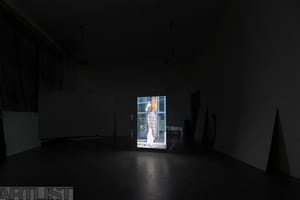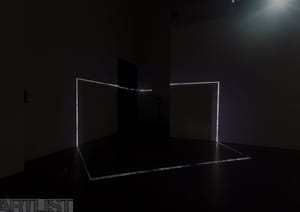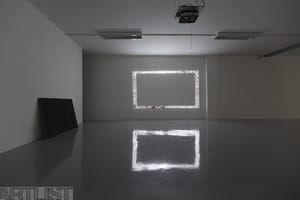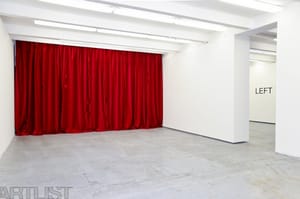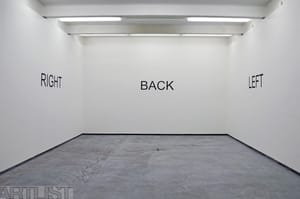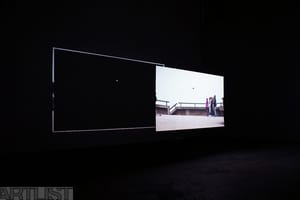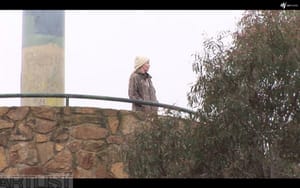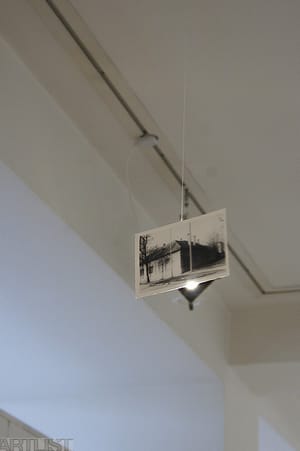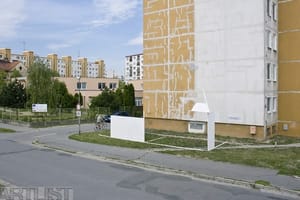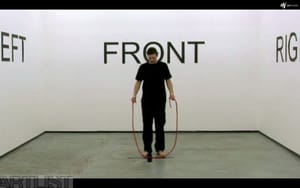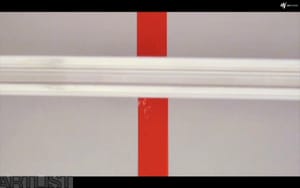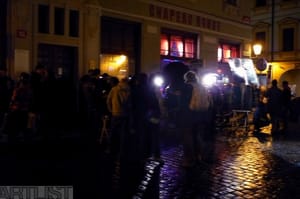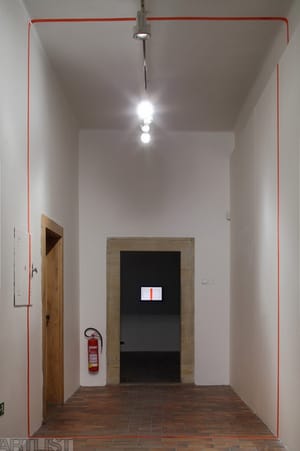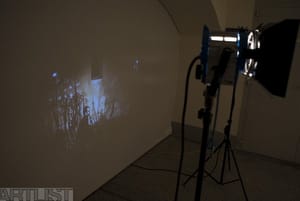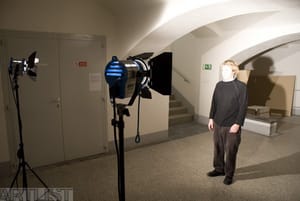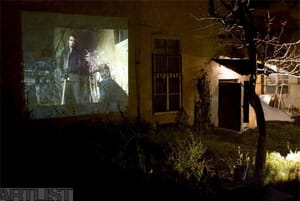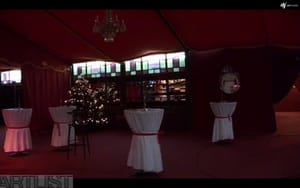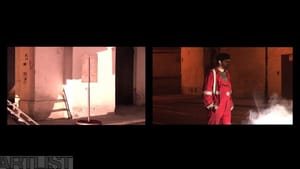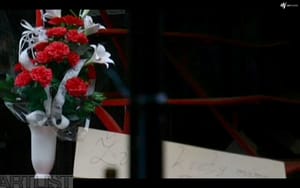- First Name
- Viktor
- Surname
- Takáč
- Born
- 1982
- Place of work
- Praha
- Website
- viktortakac.cz
- CSU Library
- ↳ Find in the catalogue
About artist
Viktor Takáč works with video and installations as well as performance and happenings. Two main motifs run through his oeuvre. The first involves navigation of the viewer through space. The second involves reflections upon video as medium, along with the conditions of its creation and perception. In most works these two lines intersect and a situation arises whose spatial conditions relate to the theme of the work.
The relationship between artist and viewer is of paramount importance. Takáč configures default conditions that the observer reflects on and often expands. The artist explores this dialogue within the context of the moving image. Whether this involves traditional projection or the spatial layering of projections and television in a gallery, he is interested in how the viewer defines themself in relation to the moving images and, on the contrary, what option the observer has to change these images.
This feature is best illustrated in the video installation Staircase Effect II (2011), in which a video is projected onto the wall. However, two reflectors stand in front of the wall that shine a bright light into the face of the viewer. The closer the viewer gets in order to see the projected image, the more they are blinded by the light. This is a physically unpleasant and alienating effect that obliges the viewer to decide on what position (relationship) to adopt vis-à-vis the moving image.
In the installation Studio Retrospective (2013), Takáč conceives of space as a mental map and navigates the viewer through the reconstructed backdrops of his earlier video work. For instance, the first room is an environment similar to that in which Takáč shot Front, Back, Left, Right (with Michal Pěchouček, 2011). This means that the observer does not see the original video, but finds themselves in a kind of three-dimensional retrospective image. The artist is posing questions: where is the genuine content of digitally filmed activities to be found? What is the relationship between reality and the recording thereof? Which of these is the more authentic?
Although a turn within the medium or technological apparatus is typical of Takáč’s work, this is always accompanied by an interest in the image and display itself. The formal and conceptual relationships under examination are encoded in specific images. These are most often of a documentary or minimalist character. They reveal to us a certain segment of quotidian reality. The artist is therefore not interested in reducing the moving image to formal principles, but in uncovering them against the background of everyday life.
The combination of the technical and the poetic is best illustrated in Mr. Möbius Lives on the 2nd Floor (2007), which elucidates a scientific principle, namely the geometry of the Möbius strip, a surface that always has only one side and one edge. The resulting video comprises two moving images that use a circular pattern (the rotational movement of the camera) to capture reality, until at one point they meet and merge into each other. It is a video without beginning or end, an endless loop. The content of the video in itself has no relationship to the formal principles it embodies. It was selected intuitively, though the night-time monitoring of repairs to tram lines contains the requisite visual intensity thanks to the light and colour conditions. And though this is a simple recording of reality, the slow, mechanical movement of the camera lends the video a mysterious atmosphere, as though this were a blocked scene (in the theatrical sense) from an experimental detective story.
Another example of this tendency is the installation White is When (2012), in which a video is split into two parts by the spatial organisation of the projection. The original video was projected onto a white plate with a small circular hole. However, the dimension of the projection was larger than the plate, and so the remainder of the image was projected onto the wall behind the plant with a kind of frame with a circle in the middle. As well as the spatial deconstruction of the video projected, we can also observe the moment that links the spatial organisation and the character by which the video was edited. The shots are again a record of everyday reality and the camera follows emotionlessly figures in a neutral environment. However, as soon as a figure intersects the circular sector in the board, the film cuts to another shot. The form of the video and the form of its installation mutual respond to each other in a cyclical dialogue.
New Castles (2012), on the other hand, represents a project determined by the personal story of an old woman whose former house is long gone to be replaced by an apartment block. Takáč reflects upon the question of our memory of place and time. On the original plot of land he creates a stylised reconstruction of the women’s former home. In the installation he then exhibits photographs of the intervention in public space along with a video that represents the documentation of the personal belongings of the woman. The result is that her story is not presented in a continuous stream of pictures and works, but is fragmented in time and space. And it is again the viewer who uses their imagination to the form the intermediary between the past and the present.
In his most recent projects Takáč has displayed an interest in cooperation. This applies to the exhibition Black Light (2015) with Anna Hulačová, as well as Camera: Petr Krátký, Viktor Takáč, Zuzana Žabková (2014). These projects involve a mutual dialogue and a gesture toward leaving the works open to interpretation and sometimes to deconstruction by the other.
The performance Manifestation of a Medium (2015) with Petr Krátký took place in a similarly collective spirit. It comprises a darkened room in which both performers build a construction prepared in advance. Viewers were thrown back on their hearing, imagination, and on a flash of photographic light that appeared once every twenty seconds. The two artists assembled and disassembled the construction during the course of the performance, which meant that the observer was faced with a derived movement that they were only able to perceive with their eyes during short time segments. The action took place to the rhythm of the alternation of darkness and short flashes, by which means the artists referenced the medium of the moving image as such, i.e. to the illusory principle of the evocation of motion, in which film or digital video in reality comprises static images interspersed with black frames that the human eye, when these are projected at sufficient speed, interprets as continuous movement.
- Author of the annotation
- František Fekete
- Published
- 2017
CV
Studies:
2007–2012
Academy of Fine Arts, AVU, Prague:
Master’s programme in Intermedia Studies workshop of: Jiří Příhoda
Master’s programme in New Media workshop of: Michael Bielický
2005
Student mobility programme
Department of Sculpture, Object and Installation
Academy of Fine Arts and Design, Bratislava, SK
2004–2007
Bachelor in Illustration for the Medias and Multimedia Design Institute of Art and Design, Pilsen
Awards:
2013
ESSL ART AWARD CEE 2013: First Prize
Vienna Insurance Group – Special Invitation
2007
“Other visions”: First Prize, Olomouc Festival of Film Animation
Exhibitions
- Solo exhibitions
-
2015
Černé světlo (s Anna Hulačová Litvanová), galerie Fotograf, Praha
Demonstration of Medium (s Petr Krátký), Greenhouse, Berlin
2013
Studio retrospektiv, Gallery Jiří Švestka, Praha
2012
Bílá je když, galerie Kostka – Meet Factory, Praha
2011
Diplopie prostoru, galerie Fenester, Praha
2010
Since the beginning until now, Školská 28 gallery, Praha
Intubation, 100m3 gallery, Mělník
I’ll be right back, galerie Pavilon,, Praha
2009
Efekt schodiště, galerie Ve sklepě, Praha
2008
Pavilon, galerie Pavilon, Praha
2007
How to explain video art to snails, s Erikem Sikorou, Austrian Cultural Forum, Praha
- Group exhibitions not included in ARTLIST.
-
2015
OFF2 BIENNALE, Veletržní palác, Praha
Možná už se to stalo, Vitrína Deniska, Olomouc
2014
Roxy visuals vol. 3, club ROXY, Praha
Kamera: Petr Krátký, Viktor Takáč, Zuzana Žabková, galerie KABINET T., Zlín
VIG special invitation – Junge Kunst aus CEE, Wien, AU
2013
ESSL ART AWARD – 1st prize, FUTURA, Praha
Hi5, Dům umění města Brna, Brno
2012
VI. Zlínský salón mladých, 2012, Zlín
Ostrovy odporu: Mezi první a druhou modernitou 1985–2012, Praha
2011
Hodiny v umění, s Michalem Pěchoučkem, Galerie hlavní města Prahy, Dům U Kamenného zvonu, Praha
Za pět dvanáct, galerie FUTURA, Praha
Tabula rázná, chapel Liběchov
I Got Life, ANU – School of Art, Canberra, AUS
2010
Collectors “The Czecho-Slovak Pavillion”, Brot Kunsthalle, Vienna, AU
Dny otevřených dveří, galerie Jelení, Praha
Demoraum, Akademie der bildenden Kunste, Vienna, AU
Artyčok ArtFair, Meetfactory, Praha
Kluci a holky kterejm to nevadé, galerie Sam83, Plzeň
2009
The Dearest, galerie Půda, Jihlava
Animation Object: The Third Sense, Zlín
Bad filming, Brno Contemporary Art Center, Brno
2007
galerie Output, Praha
Elektronické ovce, GAVU, Praha
2006
Falešná stezka, Policejní muzeum, Praha
2005
Serial Systems, Plauen, DE
2004
The Lay of the Love and Death of Cornet Christopher Rilke by Rainer Maria Rilke, Praha
- Collections
- 2011, soukromá sbírka, Istanbul, TR

